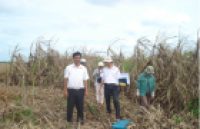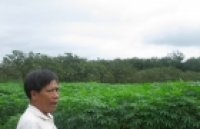| APIP5 functions as a transcription factor and an RNA-binding protein to modulate cell death and immunity in rice |
|
Many transcription factors (TFs) in animals bind to both DNA and mRNA, regulating transcription and mRNA turnover. However, whether plant TFs function at both the transcriptional and post-transcriptional levels remains unknown. The rice (Oryza sativa) bZIP TF AVRPIZ-T-INTERACTING PROTEIN 5 (APIP5) negatively regulates programmed cell death and blast resistance and is targeted by the effector AvrPiz-t of the blast fungus Magnaporthe oryzae. |
|
Fan Zhang, Hong Fang , Min Wang, Feng He, Hui Tao, Ruyi Wang, Jiawei Long, Jiyang Wang, Guo-Liang Wang, Yuese Ning Nucleic Acids Res.; 2022 May 20; 50(9):5064-5079. doi: 10.1093/nar/gkac316. AbstractMany transcription factors (TFs) in animals bind to both DNA and mRNA, regulating transcription and mRNA turnover. However, whether plant TFs function at both the transcriptional and post-transcriptional levels remains unknown. The rice (Oryza sativa) bZIP TF AVRPIZ-T-INTERACTING PROTEIN 5 (APIP5) negatively regulates programmed cell death and blast resistance and is targeted by the effector AvrPiz-t of the blast fungus Magnaporthe oryzae. We demonstrate that the nuclear localization signal of APIP5 is essential for APIP5-mediated suppression of cell death and blast resistance. APIP5 directly targets two genes that positively regulate blast resistance: the cell wall-associated kinase gene OsWAK5 and the cytochrome P450 gene CYP72A1. APIP5 inhibits OsWAK5 expression and thus limits lignin accumulation; moreover, APIP5 inhibits CYP72A1 expression and thus limits reactive oxygen species production and defense compounds accumulation. Remarkably, APIP5 acts as an RNA-binding protein to regulate mRNA turnover of the cell death- and defense-related genes OsLSD1 and OsRac1. Therefore, APIP5 plays dual roles, acting as TF to regulate gene expression in the nucleus and as an RNA-binding protein to regulate mRNA turnover in the cytoplasm, a previously unidentified regulatory mechanism of plant TFs at the transcriptional and post-transcriptional levels.
See https://pubmed.ncbi.nlm.nih.gov/35524572/
Developmental- and pathogen-dependent nuclear accumulation of GFP-APIP5. (A) GFP-APIP5 abundance in cytosolic- and nuclei-enriched fractions from GFP-APIP5 transgenic plants at the seedling and tillering stages. S represents the seedling stage; T represents the tillering stage. Histone H3 served as a nuclear marker and HSP as a cytosolic marker. The experiment was repeated twice (biological replicates) with similar results, and the representative data from one replicate are shown. (B) GFP-APIP5nls abundance in cytosolic- and nuclei-enriched fractions from GFP-APIP5nls transgenic plants at the seedling and tillering stages. S represents the seedling stage; T represents the tillering stage. Histone H3 served as a nuclear marker and HSP as a cytosolic marker. The experiment was repeated twice (biological replicates) with similar results, and the representative data from one replicate are shown. (C) Confocal images showing the subcellular localization of GFP-APIP5 transiently expressed in the leaves of 1- and 2-month-old N. benthamiana plants. mCherry was used a whole-cell localization marker. Scale bars represent 20 μm. (D) GFP-APIP5 abundance in cytosolic- and nuclei-enriched fractions from 1- to 2-month-old N. benthamiana plants. Histone H3 served as a nuclear marker and Actin as a cytosolic marker. The experiment was repeated twice (biological replicates) with similar results, and the representative data from one replicate are shown. (E) GFP-APIP5 abundance in cytosolic- and nuclei-enriched fractions from 3-week-old GFP-APIP5 transgenic plants after inoculation with RO1-1. DAI represents day after inoculation. The experiment was repeated twice (biological replicates) with similar results, and the representative data from one replicate are shown.
|
|
|
|
[ Tin tức liên quan ]___________________________________________________
|


 Curently online :
Curently online :
 Total visitors :
Total visitors :
(107).png)


